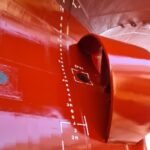Market Insights
Paints and coatings for antifouling Market size is anticipated to increase at a CAGR of 9.1% from 2020 to 2025, reaching $13.06 billion. Antifouling paints and coatings are a specific kind of coating that are painted on the bottom of a ship or marine vessel to stop or slow down the deterioration of the metallic surface that is still submerged. It aids in increasing the durability and effectiveness of vessels. Furthermore useful for stationary and floating offshore oil rigs are these marine paints. The rising demand from the maritime industry is anticipated to fuel the expansion of the market for antifouling paints and coatings.
Report Coverage
The following antifouling paints & coatings industry segments are covered in detail in the IndustryARC study, “Antifouling Paints & Coatings Market- Forecast (2020-2025)”.
By Type: Copper-Based, Self-Polishing, Hybrid, Hard antifouling, Eroding antifouling, and Others
By Application: Shipping Vessels, Drilling Rigs & Production Platforms, Fishing Boats, Yachts & other Boats, Inland Waterways Transport, Mooring Lines
By Region
- North America
- U.S.
- Canada
- Mexico
- Europe
- Germany
- France
- UK
- Spain
- Italy
- Rest of Europe
- Asia-Pacific
- China
- India
- Japan
- South Korea
- Australia
- Rest of Asia-Pacific
- LAMEA
- Brazil
- Saudi Arabia
- South Africa
- Rest of LAMEA
Segment Analysis – By Type
In 2019, the market for antifouling paints and coatings was dominated by hard antifouling. In order to prevent fouling organisms, hard antifouling releases biocide from the coating’s surface. Although abrasive water particles, such as silt and sand, may only slightly reduce the film build, hard antifouling doesn’t truly wear. Over the course of the product’s life, the biocide leaching rate decreases. There can be a buildup of leftover product after a few seasons that needs to be eliminated. They are typically used on boats anchored in fresh water because antifouling is made to erode in salt water and may not erode properly in pure water. In the market for antifouling paints and coatings, eroding antifouling had the second-largest market share. Antifouling that erodes, commonly referred to as soft antifouling or ablative antifouling, also works by releasing biocide. Nevertheless, this kind of excessive antifouling slowly erodes in the seawater, eventually leaving your hull with little to no antifouling. Any time you clean the hull, you’ll notice a tiny cloud of product washing away. In a variety of fouling circumstances, eroding antifouling provides very good all-around performance. During the anticipated term, this aspect will fuel the market’s expansion.
Segment Analysis – By Application
In 2019, the antifouling paints & coatings market’s highest share belonged to the shipping vessels segment, which experienced a CAGR of 10.2%. A process known as biofouling occurs when microbes, plants, or algae accumulate in the hull of a ship over time. These organisms, usually referred to as invasive aquatic species, can have a negative impact on a ship’s performance and pose a risk to the maritime environment. Antifouling is the technique of shielding a ship’s hull from these organisms with specially formulated materials, such as specialized paints and coatings that stop them from accumulating in the hull. extending the time between dry dock visits and using more antifouling paints and coatings to safeguard vessels from the growth of fouling organisms. Antifouling paints and coatings are used on shipping vessels to decrease frictional resistance and stop fouling organisms from adhering to the hulls, which helps shipping vessels consume less fuel. During the anticipated term, this aspect will fuel the market’s expansion.
The public is extremely concerned about maintaining health and safety on board transportation vessels in light of the recent and ongoing global outbreak of the coronavirus (COVID-19). There are worries in the sector that the effects of COVID-19 will have a long-term negative influence on sales, especially in the Asian market, which has recently grown to be a highly important market for shipping vessel firms. Yet, once things return to normal, it will continue to increase steadily throughout the predicted period.
Segment Analysis – By Geography
With a share of more than 48%, Asia-Pacific (APAC) led the antifouling paints and coatings market, followed by North America and Europe. The economy of APAC is mostly driven by the economic dynamics of nations like China and India, although the current situation is changing due to an increase in foreign direct investment for the growth of South East Asia’s economy. Countries in South East Asia have seen an increase in demand, which can be ascribed to the area’s expanding shipbuilding industry. The top three nations in Asia-Pacific for shipbuilding are China, Korea, and Japan. The development of the antifouling paints & coatings market in these nations is anticipated to be fueled by the low cost of labour and raw materials as well as the introduction of cutting-edge products. Furthermore, it is anticipated that rising spending on crude oil and natural gas exploration and production in China, India, and Thailand would further boost demand for these paints in drilling rigs and production platforms. Furthermore, due to governmental assistance for encouraging new investments at the local level, Australia and India are likely to become major marine vessel manufacturing hubs. Throughout the projected period, this factor will propel the market for antifouling paints & coatings.
Market Dynamics:
Drivers:
Due to the necessity of importing and exporting commodities, which was brought on by globalization, antifouling coating became a significant and essential industry. The development and planning of nautical vessels across the globe is the responsibility of the antifouling coating industry. Currently, Asian countries like China, Japan, and South Korea produce the largest bulk of the world’s boats, although there are also sizable shipyards in many other countries. Boat development and alterations are the focus of the shipbuilding industry, and they are carried out in specialized facilities known as shipyards.
Opportunities:
The growing oil and gas industry, rising outsourcing efforts, and recent advancements in transportation coordination are all factors enhancing the growth of the antifouling coatings market. Over the long run, many countries have developed significant interests in the transportation industry. This will result in a significant increase in demand for antifouling coatings, creating a few development opportunities for market vendors.
Restraints:
The value instability of the important raw materials used to make antifouling coatings is likely to restrain market growth for these products globally during the projected time period.
Cumulative Growth Analysis:
The extensive effort being done in the seaward region to cover delivering vessels, secure lines, and cover penetration apparatuses is beneficial to the antifouling coatings market. The market for antifouling coatings will likely be driven in the coming years by growing interest in antifouling paint and covering from the gas and oil industry. Also, the market for antifouling coatings is strengthened by common characteristics like fouling free. Also, in order to provide new roads in the upcoming years, there will be a growing demand from advanced nations and other end-clients, such as the gas and oil sector.
Major Market Players:
The Key Players of Antifouling Coating Market include:
- AkzoNobel N.V.
- Sherwin Williams Company
- Jotun
- PPG Industries Inc.
- Kansai Paint Co., Ltd.
- Nippon Paint Holdings Co. Ltd
- BASF SE
- Chugoku Marine Paints, Ltd.
- Boero
- Hempel A/s



